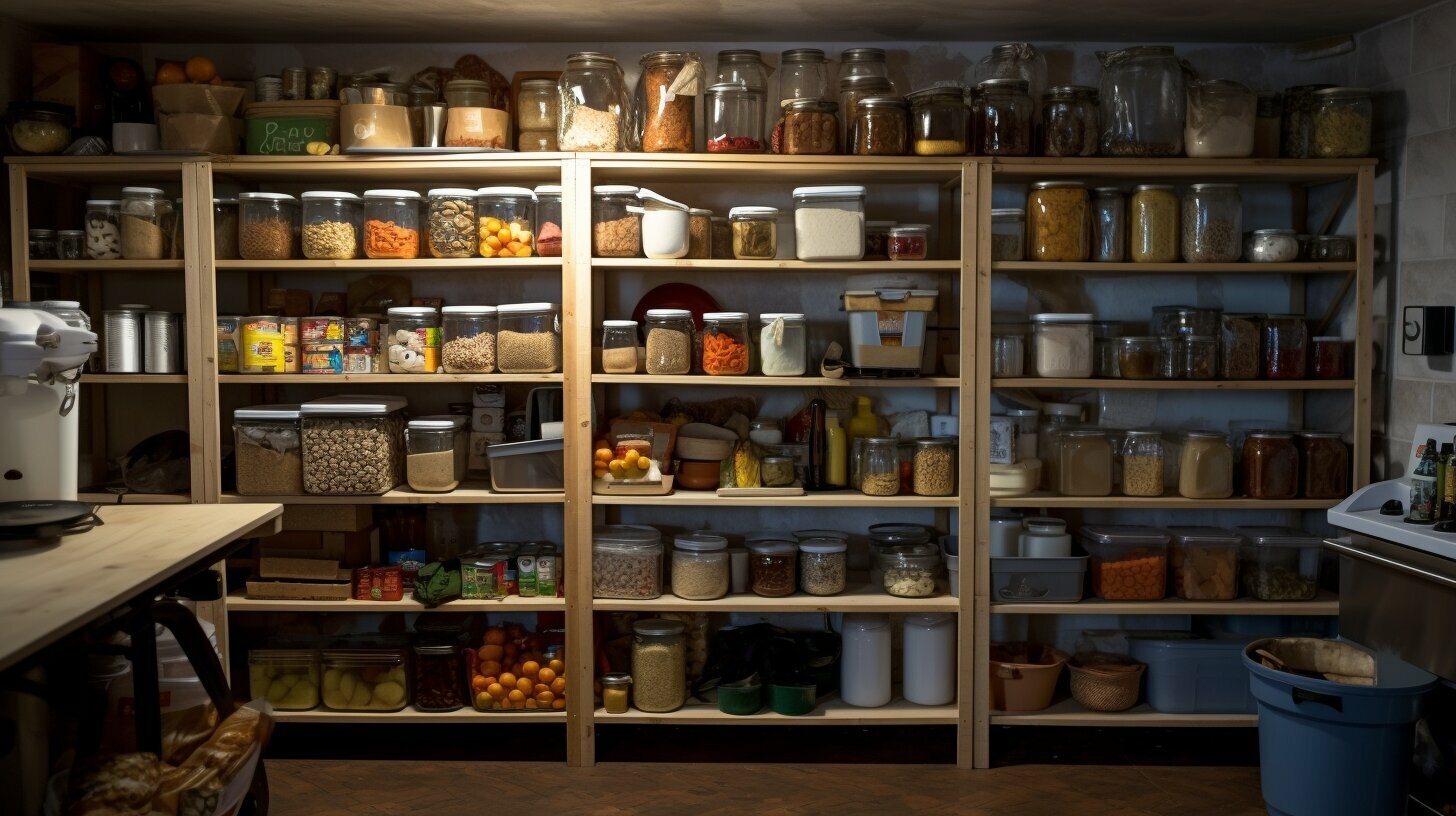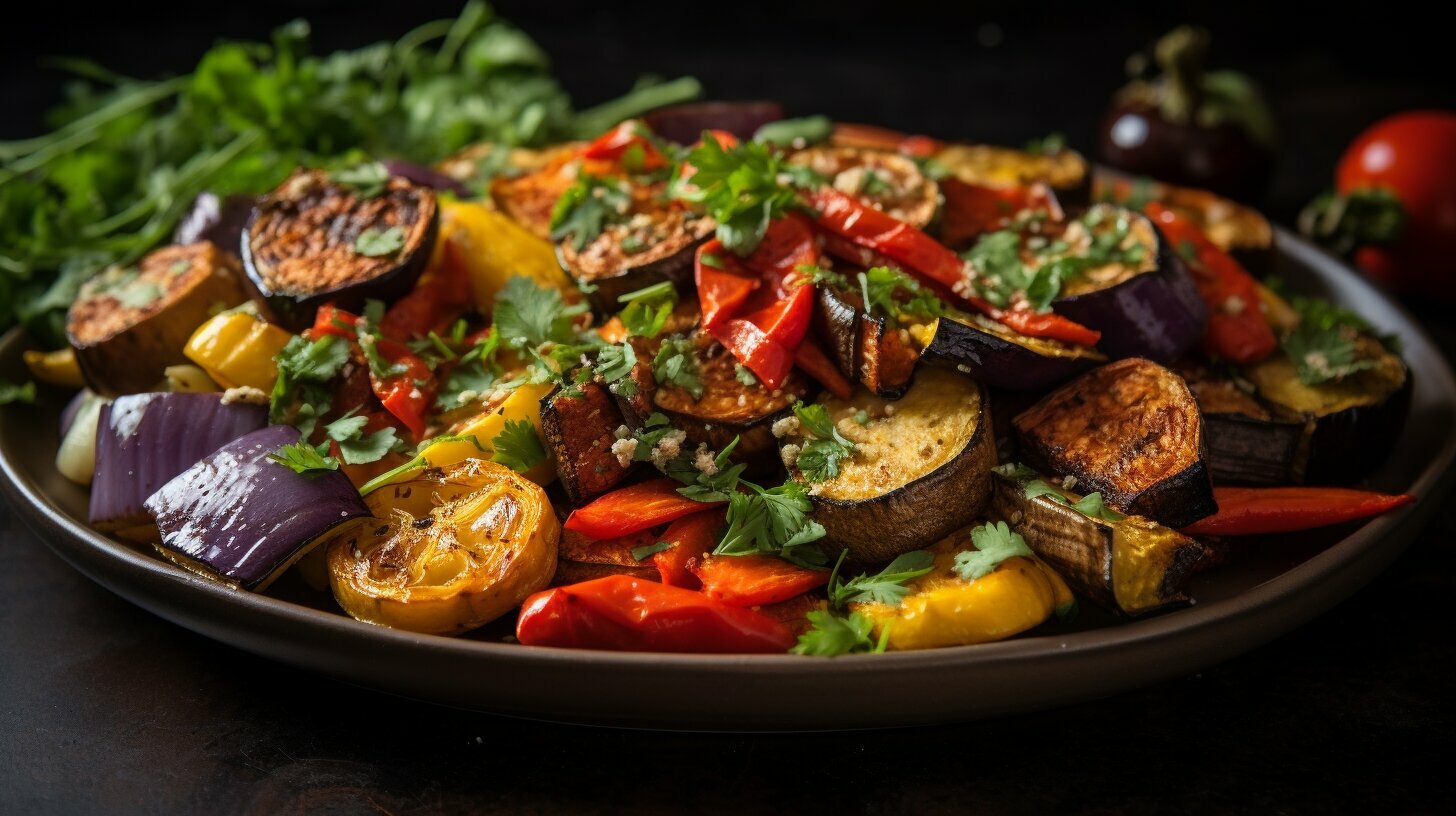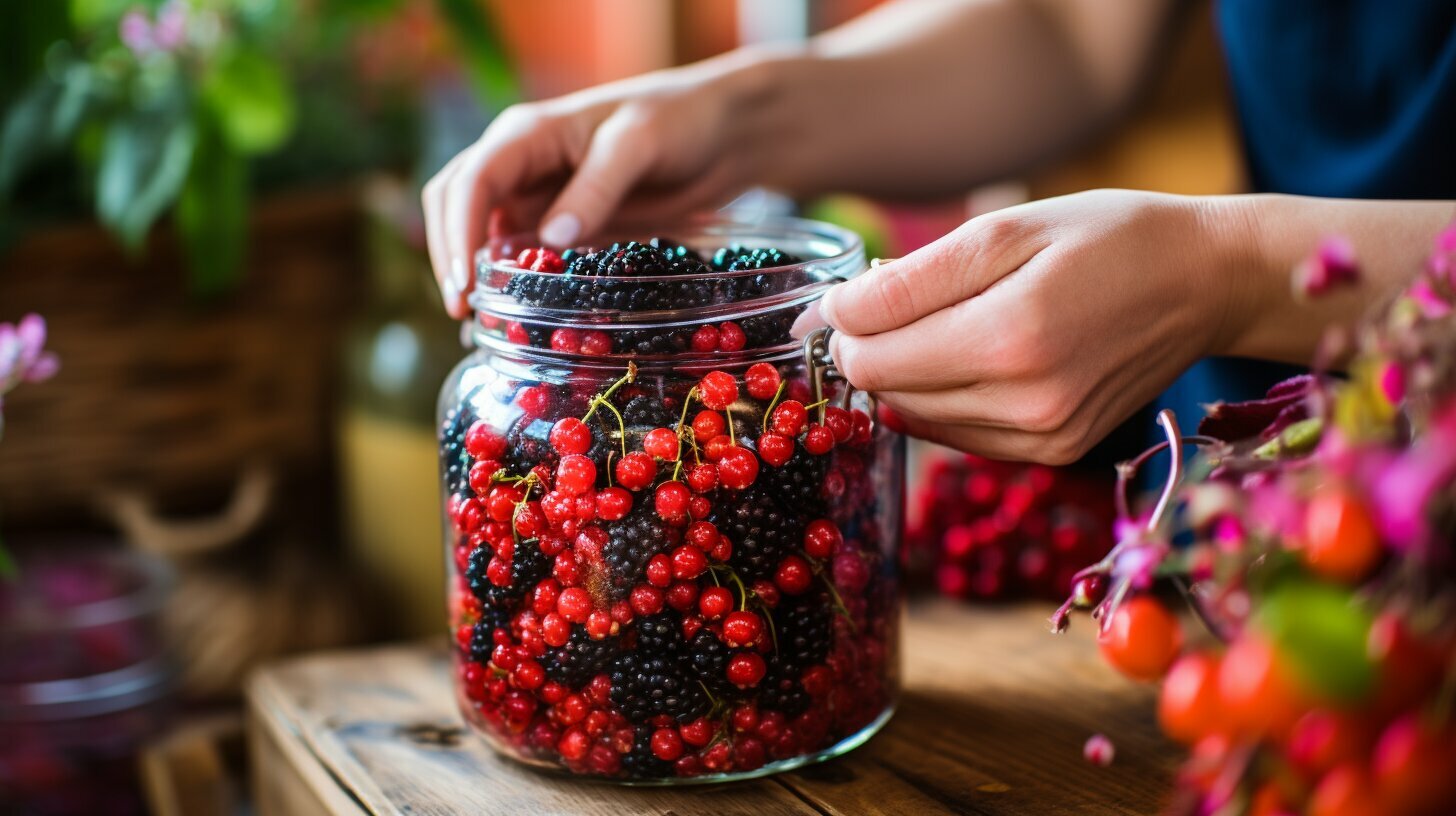Whether you are a seasoned prepper or just starting out, having a well-stocked food supply is crucial for preparedness. With the unpredictability of emergencies, natural disasters, and other crises, having enough food to sustain yourself and your loved ones is essential. In this comprehensive guide, we will explore the essential aspects of food storage for preppers, including long-term food storage, emergency food storage, prepper pantry organization, and more.
Key Takeaways
- Food storage for preppers is essential for preparedness and survival.
- Long-term food storage and emergency food storage are crucial components of prepper food storage.
- Proper organization of a prepper pantry is key to maintaining a well-stocked food supply.
- Choosing the best food storage containers and regularly rotating your food supply are important for maintaining food quality.
- Supplementing your food storage with fresh ingredients and creating meal plans can provide additional nutritional value and variety.
- Water storage is also essential for preppers, along with prepper supplies such as medical supplies, hygiene products, tools, and equipment.
Why Food Storage is Crucial for Preppers
As a prepper, you understand the importance of being prepared for any situation that may arise. One of the most critical aspects of preparedness is having a well-stocked food supply. Food storage for preppers is not just about stockpiling canned goods and other foods; it’s about long-term planning to ensure that you and your loved ones have access to sustenance during emergencies or periods of uncertainty.
Long-term food storage is necessary because you never know how long an emergency could last. It’s crucial to have a sufficient amount of food to sustain you and your family for an extended period. Emergency food storage is equally important, as unforeseen circumstances can arise when you least expect them. Having a stockpile of food can give you peace of mind and help you avoid the panic that can come with an emergency situation.
Disclosure: When you buy through links on our site, we may earn an affiliate commission.
A prepper pantry is an essential part of food storage for preppers. It’s a designated space where you keep your food, and it allows you to organize and manage your food supply effectively. Having a prepper pantry allows you to keep track of what food you have and when it expires, so you can avoid wasting food.
Survival food storage is not a luxury; it’s a necessity. It’s vital to plan and prepare your food supply in advance, so it’s readily available when you need it most. In the event of an emergency, you may not have access to grocery stores or restaurants, and having a well-stocked food supply is critical to your survival.
In the next sections of this guide, we will explore how to assess your food storage needs, build a prepper pantry, select the right foods for long-term storage, preserve food for extended storage, rotate and maintain your food supply, supplement your food storage with fresh ingredients, create meal plans and recipes for preppers, store water for emergencies, and manage your prepper supplies.
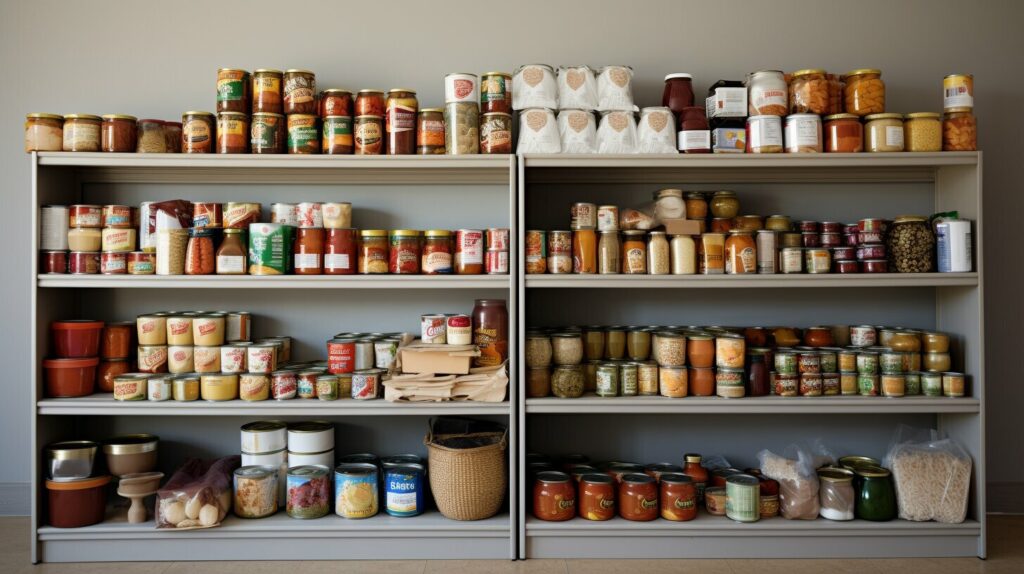
Assessing Your Food Storage Needs
Before you start building your food storage for preppers, it is essential to assess your specific needs. Planning ahead is crucial in ensuring that you have enough food for yourself and your family during emergencies or disasters. To determine your food storage needs, consider the following factors:
- Number of people: Start by calculating how many people you will be providing food for. This can include family members, roommates, and even close neighbors who may need your help during an emergency.
- Duration: How long do you want your food storage to last? Consider the most likely disasters in your area and plan accordingly. For example, if you live in an area prone to hurricanes, you may want to store enough food for a month or more.
- Caloric intake: It is important to ensure that you have enough calories to sustain your energy levels during an emergency. The average person needs around 2,000 calories per day, but this can vary depending on age, gender, and activity level. Plan your food storage accordingly.
- Dietary restrictions: If anyone in your household has dietary restrictions, make sure to include appropriate foods in your food storage. This can include gluten-free, dairy-free, or vegetarian options.
Once you have determined your specific needs, you can start building your prepper food storage. Make sure to include a variety of foods that are easy to store and have a long shelf life. Consider investing in prepper supplies such as storage containers and sealing equipment to ensure your food stays fresh and protected.
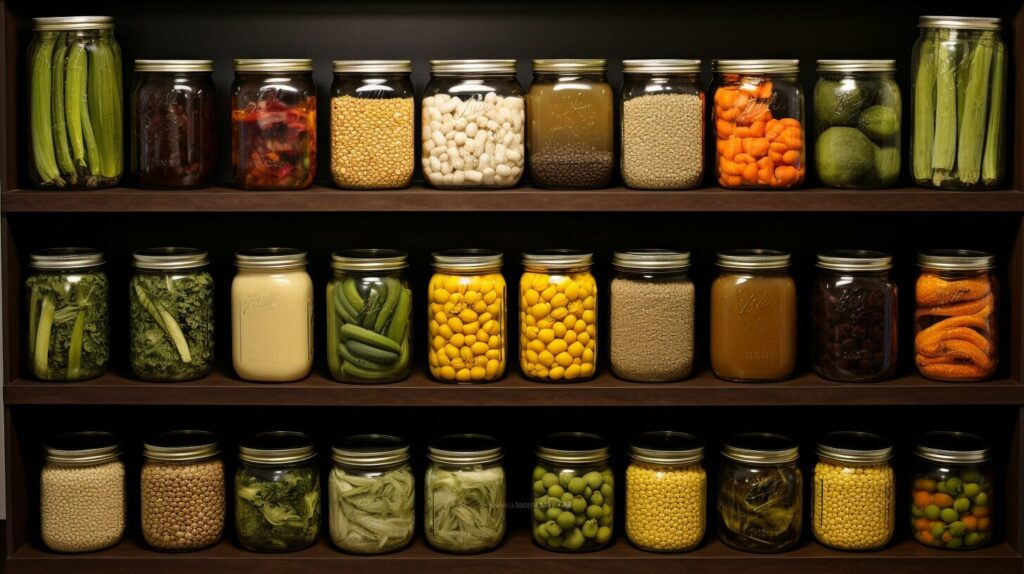
By assessing your food storage needs and planning ahead, you can have the peace of mind knowing that you and your family will be prepared for any emergency or disaster.
Building a Prepper Pantry
A prepper pantry is a vital component of food storage for preppers. It’s where you store all of your non-perishable food items, such as canned goods, rice, pasta, and other essential supplies. By having a well-stocked prepper pantry, you can ensure that you have access to food during emergencies, natural disasters, or any other situation that disrupts the food supply chain.
Here are some essential steps to follow when building your prepper pantry:
Step 1: Determine Your Storage Space
The first step in building a prepper pantry is to determine how much space you have available for storage. You can use a spare closet, a spare room, or even a corner of your basement or garage. Once you have determined your storage space, you can decide on the size and type of shelves or storage containers you will need.
Step 2: Choose the Best Food Storage Containers
The best food storage containers for prepper pantries are those that are airtight, durable, and easy to stack. Mason jars, buckets with gamma lids, and plastic storage containers with snap-on lids are all good options. Make sure to label each container with the contents and the date of storage.
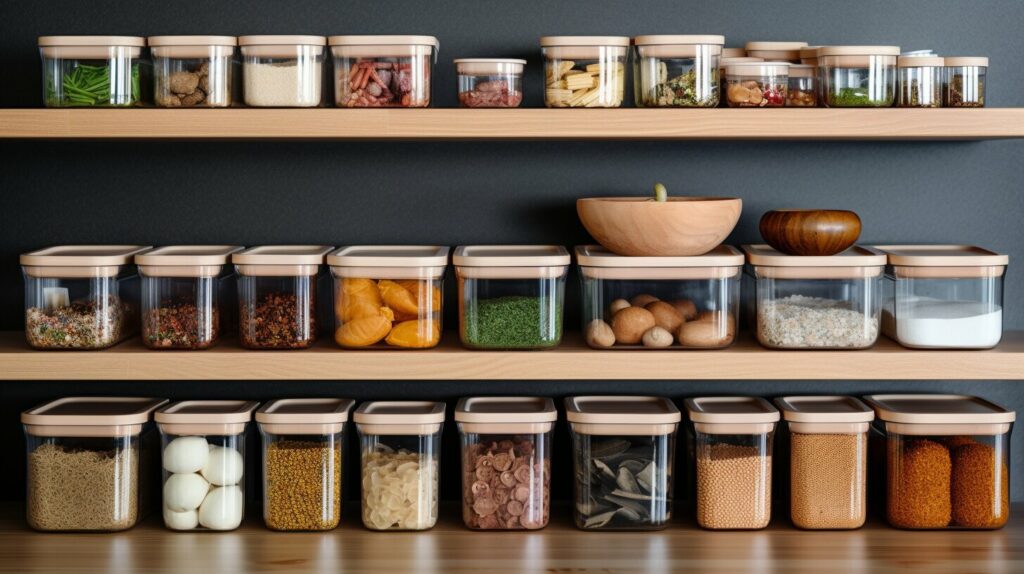
Step 3: Stock Up on Long-Term Food Storage Items
The items you stock in your prepper pantry should have a long shelf life and be easy to prepare. Some good options include canned fruits and vegetables, dried beans, rice, pasta, oats, and peanut butter. Be sure to rotate your items regularly and replace any expired items.
Step 4: Include Emergency Food Storage Items
In addition to long-term food storage items, you should also include emergency food storage items that require no preparation. These can include items like protein bars, jerky, and meal replacement shakes.
Step 5: Manage Your Inventory Effectively
Managing your inventory is critical to building an effective prepper pantry. Keep a detailed inventory of items, including the date of purchase and expiration. Regularly rotate your items, using the oldest items first, and replace any expired items.
By following these steps, you can build a well-organized and well-stocked prepper pantry that will provide you with the food you need in any emergency situation.
Selecting the Right Foods for Long-Term Storage
When it comes to long-term food storage for preppers, not all foods are created equal. It’s essential to choose foods that have a long shelf life and can withstand the storage conditions. Here are some tips to help you select the best foods for long-term storage.
Look for Foods with a Long Shelf Life
The first thing to consider is the shelf life of the food. Look for foods that have a long shelf life, such as:
- Canned foods: Canned foods are an excellent option since they can last for several years and are easy to store. Look for low-acid canned foods like canned meats, vegetables, and fruits.
- Dried foods: Dried foods like beans, rice, pasta, and jerky can also last for several years if stored correctly.
- Dehydrated foods: Dehydrated foods like fruits and vegetables can also last for several years if stored in airtight containers.
When storing these foods, make sure to keep them in a cool, dry place away from direct sunlight.
Consider the Nutritional Value
When selecting foods for long-term storage, it’s also essential to consider the nutritional value. Look for foods that are high in protein and other essential nutrients that your body needs to survive.
Some good options include canned meats like tuna and chicken, beans, quinoa, and powdered milk. These foods provide the necessary nutrients needed to sustain your body during emergencies.
Choose the Right Containers
The containers you choose for storing your food can also impact how long they last. Look for food-grade containers that are airtight and moisture-proof. Some good options include:
- Mylar bags: Mylar bags are a great option for storing dried foods and can help protect them from moisture and pests.
- Buckets with lids: Food-grade plastic buckets with airtight lids are another good option for storing bulk foods like rice and beans.
- Glass jars: Glass jars with airtight lids are perfect for storing dehydrated fruits and vegetables.
Follow Proper Storage Techniques
Proper storage techniques are crucial for maintaining the quality of your stored foods. Here are some tips to keep in mind:
- Store foods in a cool, dry place away from direct sunlight.
- Rotate your food supply regularly, using the first in, first out (FIFO) method.
- Keep an inventory of your food supply and check it regularly to ensure it’s still in good condition.
- Consider using oxygen absorbers or desiccants to help prolong the shelf life of your stored foods.

Remember, the key to successful long-term food storage is selecting the right foods, choosing the right containers, and following proper storage techniques. By following these tips, you can ensure that your food supply will be ready when you need it most.
Selecting the Right Foods for Long-Term Storage
When it comes to long-term food storage for preppers, not all foods are created equal. Some foods have a longer shelf life than others, making them ideal for extended storage. It is essential to choose the right foods to ensure that they remain safe to eat and retain their nutritional value over time.
Here are some considerations when selecting foods for long-term storage:
- Shelf Life: Opt for foods with a long shelf life, such as grains, legumes, and canned goods. These foods can last for several years when properly stored.
- Nutrition: Choose nutrient-dense foods to ensure that you are getting the necessary vitamins and minerals. Foods such as dried fruits, nuts, and seeds are excellent sources of nutrition.
- Storage: Consider how the food will be stored. For example, some foods require airtight containers to prevent spoilage and insect infestations. Others can be stored in a cool, dry place.
Here are some of the best foods for long-term storage:
| Food | Shelf Life |
|---|---|
| Rice | Up to 30 years |
| Beans | Up to 30 years |
| Canned Foods | Up to 5 years |
| Dried Fruit | Up to 5 years |
| Powdered Milk | Up to 20 years |
| Nuts and Seeds | Up to 2 years |
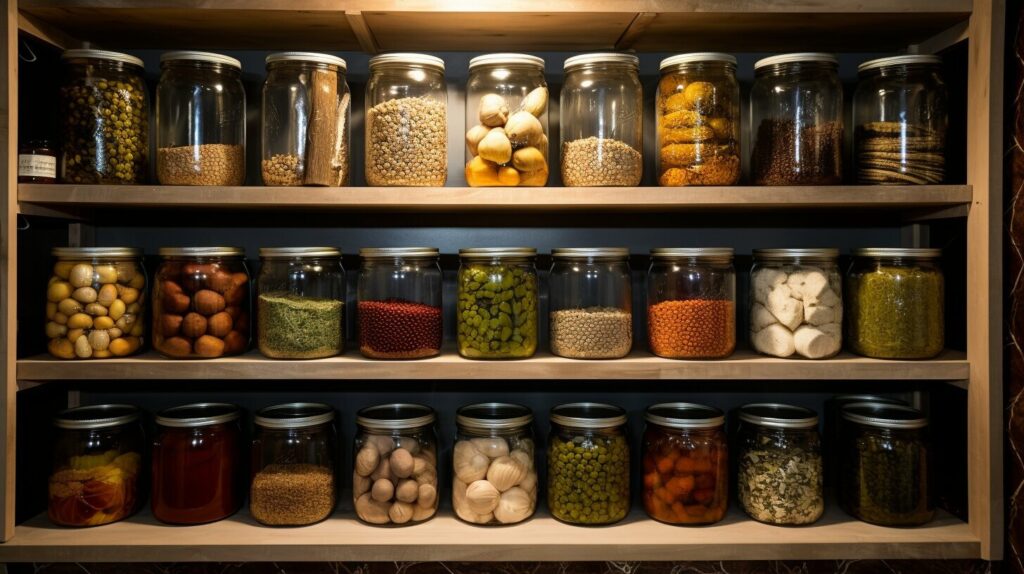
Keep in mind that even when you select the best foods for long-term storage, it is crucial to store them properly. Make sure to label and date all containers, rotate your stock, and store them in a cool, dry place away from direct sunlight. By following these guidelines, you can ensure that your stored food remains safe and nutritious for extended periods, providing peace of mind for any emergency situation.
Rotating and Maintaining Your Food Supply
Proper rotation and maintenance of your stored food supply are crucial to ensure its freshness and quality. Here are some food storage tips to keep in mind:
- First In, First Out (FIFO) Method: When organizing your food storage, use the FIFO method to ensure that the oldest items get used first. Label each item with the date of purchase or expiration, and place newer items at the back of the storage area.
- Regular Inspections: Conduct regular inspections to check for signs of spoilage, pests, or damage to the packaging. If you notice any issues, remove the affected item immediately, and adjust your storage conditions if needed.
- Temperature and Humidity Control: Store your food in a cool, dry, and dark place to prevent deterioration and spoilage. Keep the temperature below 75°F and the humidity below 15% if possible.
By following these food storage tips, you can ensure that your stored food supply remains safe, fresh, and nutritious for an extended period.
Supplementing Your Food Storage with Fresh Ingredients
While having a well-stocked prepper pantry is crucial, supplementing it with fresh ingredients can provide additional nutritional value and variety to your meals. Incorporating fresh ingredients can also help break up the monotony of stored foods, providing a welcome change in taste and texture. Here are some tips for supplementing your food storage with fresh ingredients:
- Consider growing your own produce: Whether you have a backyard or a small balcony, growing your own produce can be a great way to supplement your food storage with fresh ingredients. Consider growing vegetables that are easy to maintain, such as tomatoes, peppers, and cucumbers.
- Use canned and dried goods to make fresh meals: Canned and dried goods can be used to create fresh, delicious meals. For example, canned tomatoes and dried herbs can be used to make a flavorful pasta sauce, or canned beans and dried spices can be used to make chili.
- Stock up on fresh staples: Certain fresh ingredients can last for a long time when stored properly. For example, onions, garlic, potatoes, and apples can last for several months when stored in a cool, dry place.
Remember to rotate your fresh ingredients just like you rotate your stored foods. Use the oldest ingredients first and replace them with fresh ones as needed to prevent spoilage. By supplementing your food storage with fresh ingredients, you can maintain a balanced and nutritious diet even during emergencies.
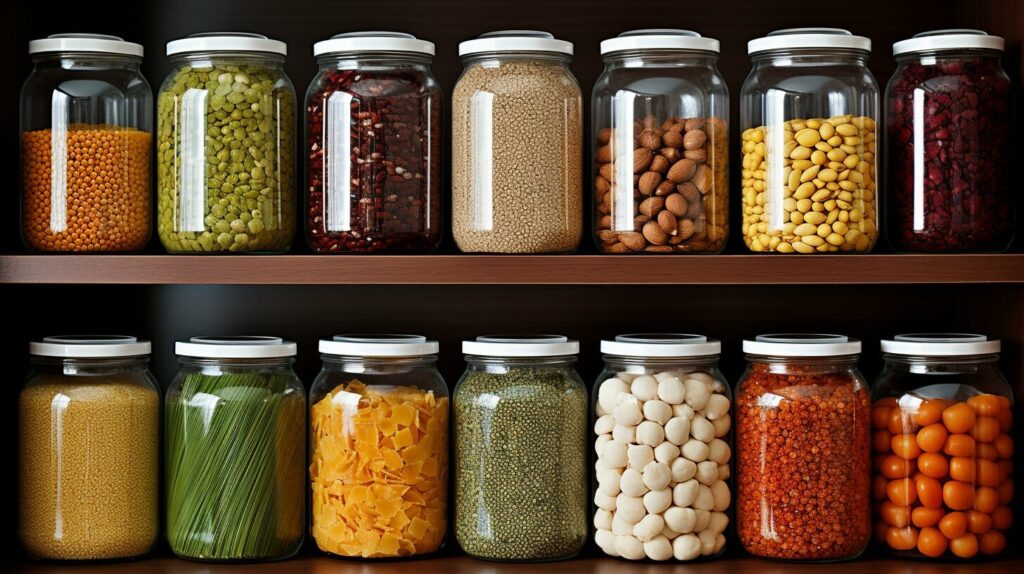
Creating Meal Plans and Recipes for Preppers
Having a properly stocked prepper pantry is essential for emergency situations, but it is also important to have a plan for using those ingredients to create nutritious meals. Developing meal plans and recipes ahead of time can help you make the most of your food storage and maintain a balanced diet during emergencies.
Start by taking inventory of the items in your prepper pantry. Consider the food storage for preppers, prepper food storage, and emergency food storage you have on hand, as well as any fresh ingredients you may be able to supplement with. Make a list of the items and quantities, and use this as a basis for your meal plan.
When designing your meal plan, aim for a balanced diet that includes a variety of food groups. Incorporate protein, grains, fruits, and vegetables whenever possible. Consider using recipes that can be easily adapted using stored ingredients, such as soups, stews, and casseroles.
Keep in mind that during emergencies, cooking methods may be limited. Plan ahead by including recipes that can be prepared using minimal equipment and resources. Canned foods can be eaten straight from the can, and dried foods can often be rehydrated with hot water.
Remember to rotate your food storage regularly and adjust your meal plan accordingly. Incorporate items that are nearing expiration into your meals to prevent waste.
Below is an example of a sample meal plan for a week:
| Day | Breakfast | Lunch | Dinner |
|---|---|---|---|
| Monday | Cereal with powdered milk | Canned soup | Chili with canned beans and tomatoes |
| Tuesday | Oatmeal with dried fruit | Tuna salad with crackers | Spaghetti with canned sauce and dried meat |
| Wednesday | Granola with powdered milk | Peanut butter and jelly sandwich | Beef stew with canned vegetables and dried herbs |
| Thursday | Scrambled eggs with canned ham | Canned chili with crackers | Vegetable stir-fry with canned vegetables and dried rice |
| Friday | Pancakes with syrup and powdered eggs | Canned chicken salad with crackers | Corn chowder with canned creamed corn and dried herbs |
| Saturday | Hash browns with canned corned beef | Trail mix with dried fruit and nuts | Taco salad with canned beans and dried meat |
| Sunday | Biscuits with canned sausage gravy | Canned beef stew | Beef and vegetable soup with canned vegetables and dried herbs |
Creating a meal plan and recipes for preppers can help you stay prepared and make the most of your food storage. With proper planning and rotation, you and your family can stay nourished during emergencies.

Storing Water for Emergencies
Alongside your emergency food storage, having an adequate water supply is crucial for preppers. Water is essential for hydration, cooking, and hygiene purposes, and you should store water to last at least a few days. In an emergency situation, water may become contaminated or scarce, so it’s vital to have a supply ready.
Emergency food storage and water go hand-in-hand. Without water, stored food becomes an issue.
There are different methods available for storing water, and the best option for you will depend on your space, needs, and resources. Here are some options for storing water:
| Storage Method | Pros | Cons |
|---|---|---|
| Bottled Water | Convenient, readily available, easy to transport | Expensive, limited shelf life, bulky |
| Large Containers | Cost-effective, can hold large amounts of water | Heavy, difficult to transport when full, may be prone to leaks or damage |
| Water Filters and Purification Kits | Can purify water from different sources, reusable, compact | May require extra resources, may not be effective against all contaminants |
It is recommended to have at least one gallon of water per person per day for drinking and basic hygiene.
Whichever method you choose, it’s essential to keep your water supply in a cool, dark place away from direct sunlight and extreme temperatures, which can affect the taste and quality of the water over time. Be sure to rotate your water supply regularly every six months, so you have access to fresh and safe drinking water when you need it most.
As part of your prepper supplies, you should also consider investing in water purification tablets, a water filtration system, or boiling equipment. These additional supplies will help you use your stored water more effectively and safely.
Managing Your Prepper Supplies
When it comes to food storage for preppers, having a well-stocked prepper pantry is just the beginning. In addition to food and water, there are several other prepper supplies that you should keep on hand to ensure your survival during emergencies.
Medical supplies are a crucial component of your prepper supplies inventory. Make sure you have a well-stocked first-aid kit, along with any necessary prescription medications. You should also consider stocking up on over-the-counter medications, such as pain relievers, antihistamines, and anti-diarrheal medications.
Hygiene products are also essential for your prepper supplies. In addition to soap, toothpaste, and toilet paper, consider stocking up on items such as hand sanitizer, feminine hygiene products, and diapers if you have young children.
Tools and equipment are necessary for survival during emergencies. Make sure you have a set of basic tools, such as a hammer, saw, and screwdriver, along with an emergency radio, flashlight, and extra batteries.
Organizing and maintaining your prepper supplies is critical to ensuring they are ready when you need them. Keep your supplies in a secure, dry location, and make sure to rotate your stockpile regularly to ensure that everything stays fresh.
By stocking up on the necessary prepper supplies, you can ensure that you are fully prepared for any emergencies that may arise. Remember, food storage for preppers goes beyond just food and water, so make sure you have everything you need to protect yourself and your loved ones.
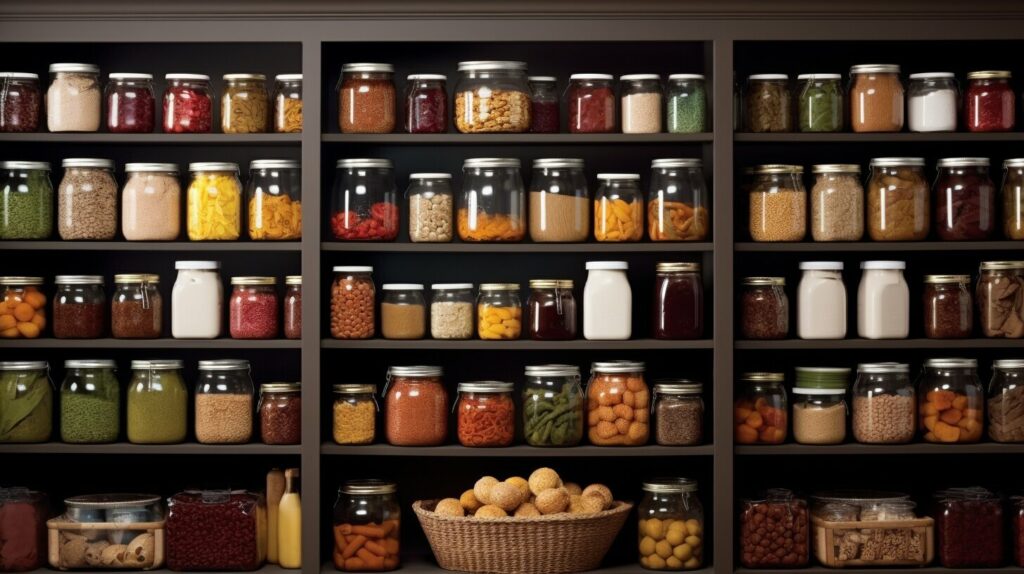
Conclusion
You have completed the ultimate guide to food storage for preppers. By now, you should have a thorough understanding of why food storage is crucial for preppers, how to assess your food storage needs, building a prepper pantry, selecting the right foods for long-term storage, preserving food for extended storage, rotating and maintaining your food supply, supplementing your food storage with fresh ingredients, creating meal plans and recipes for preppers, storing water for emergencies, and managing your prepper supplies.
Remember, staying prepared is an ongoing process. Regularly review and update your food storage and prepper supplies to ensure they meet your changing needs and circumstances. Maintaining a prepper mindset and continuously educating yourself on survival skills can make all the difference in times of crisis.
Thank you for taking the time to read this ultimate guide. We hope it has equipped you with the knowledge and tools you need to stay prepared for any circumstances that may come your way. Stay safe and stay prepared!
FAQ
Q: Why is food storage crucial for preppers?
A: Food storage is crucial for preppers because it ensures that you have an adequate supply of food during emergencies or uncertain times. It allows you to sustain yourself and your loved ones when access to fresh food may be limited.
Q: How do I assess my food storage needs?
A: Assessing your food storage needs involves determining how much food you should store, what types of food are best for preppers, and what essential prepper supplies you should have on hand. It’s important to consider factors such as the number of people in your household, dietary restrictions, and the length of time you want to be prepared for.
Q: How do I build a prepper pantry?
A: Building a prepper pantry involves setting up a well-organized space to store your food supplies. You should choose the best food storage containers to maintain the quality of your food, manage your inventory effectively, and ensure easy access to your supplies when needed.
Q: What foods are suitable for long-term storage?
A: Not all foods are suitable for long-term storage. Foods with a longer shelf life, such as grains, beans, canned goods, and dehydrated or freeze-dried foods, are ideal for long-term storage. It’s important to properly store these foods and follow food storage tips to maintain their quality over time.
Q: How can I preserve food for extended storage?
A: In addition to commercially prepared long-term storage foods, you can also preserve your own food for extended storage. Methods such as canning, dehydrating, and freezing are effective ways to preserve food. The choice of method depends on the type of food you want to preserve.
Q: How do I rotate and maintain my food supply?
A: Proper rotation and maintenance of your food supply are essential to ensure the freshness and quality of your stored food. Regularly rotate your food by using the oldest items first and replacing them with fresh supplies. Conduct regular inspections of your food storage area and address any potential issues that may arise, such as pest infestation or spoilage.
Q: How can I supplement my food storage with fresh ingredients?
A: While stored food is essential, supplementing your food storage with fresh ingredients can provide additional nutritional value and variety. You can grow your own fresh produce, incorporate dried herbs and spices, or consider trading with local farmers for fresh goods. Be mindful of the shelf life of fresh ingredients and rotate them accordingly.
Q: How do I create meal plans and recipes for preppers?
A: Creating meal plans and recipes specifically designed for your food storage can help you make the most of your prepper pantry. Consider the ingredients you have in storage and adapt recipes accordingly. Focus on maintaining a balanced diet that meets your nutritional needs during emergencies.
Q: How do I store water for emergencies?
A: Storing an adequate water supply is essential for emergencies. Consider different storage methods, such as water barrels or water bottles, and implement water purification techniques to ensure the safety of your water. Calculate your water needs based on factors such as the number of people in your household and the duration of the emergency.
Q: What other supplies should I have in my prepper inventory?
A: Prepper supplies go beyond food and water storage. It’s important to have essential items such as medical supplies, hygiene products, tools, and equipment in your inventory. Organizing and regularly maintaining your prepper supplies will ensure they are readily available when needed.

